



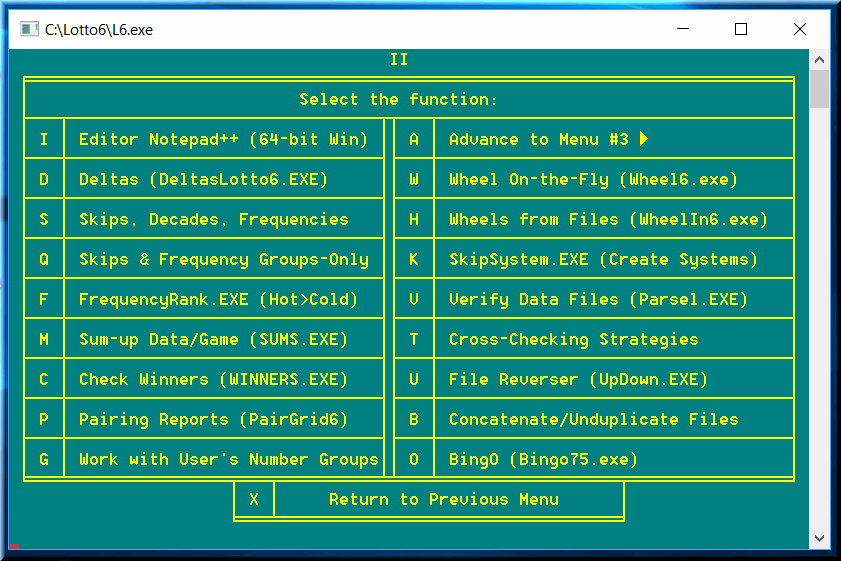
Two screenshots one for the 6-number lotto and one for pick-3 lotteries
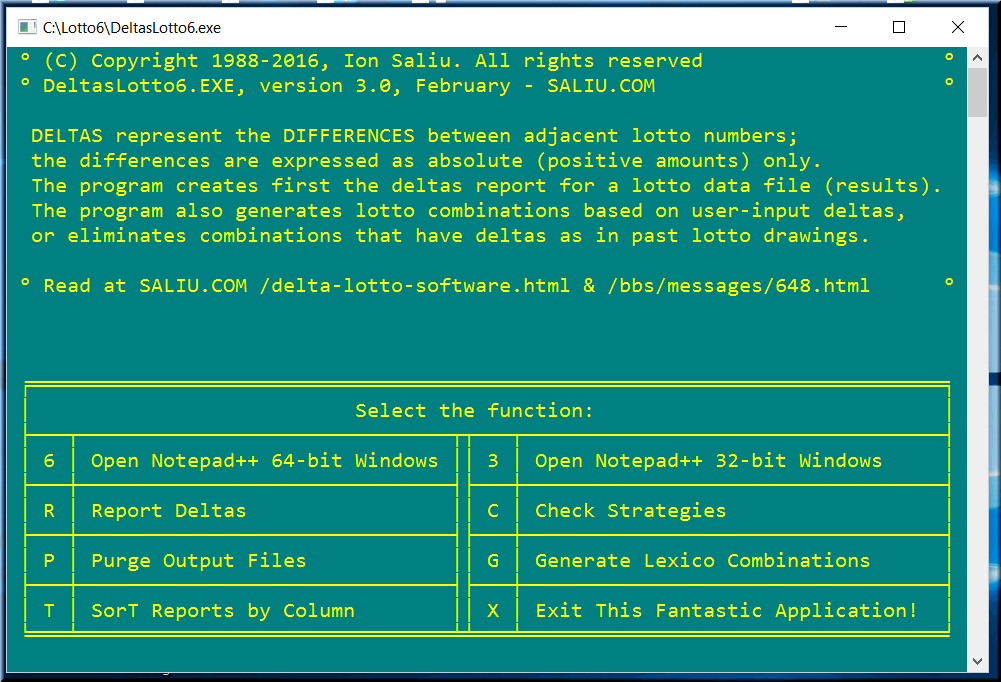
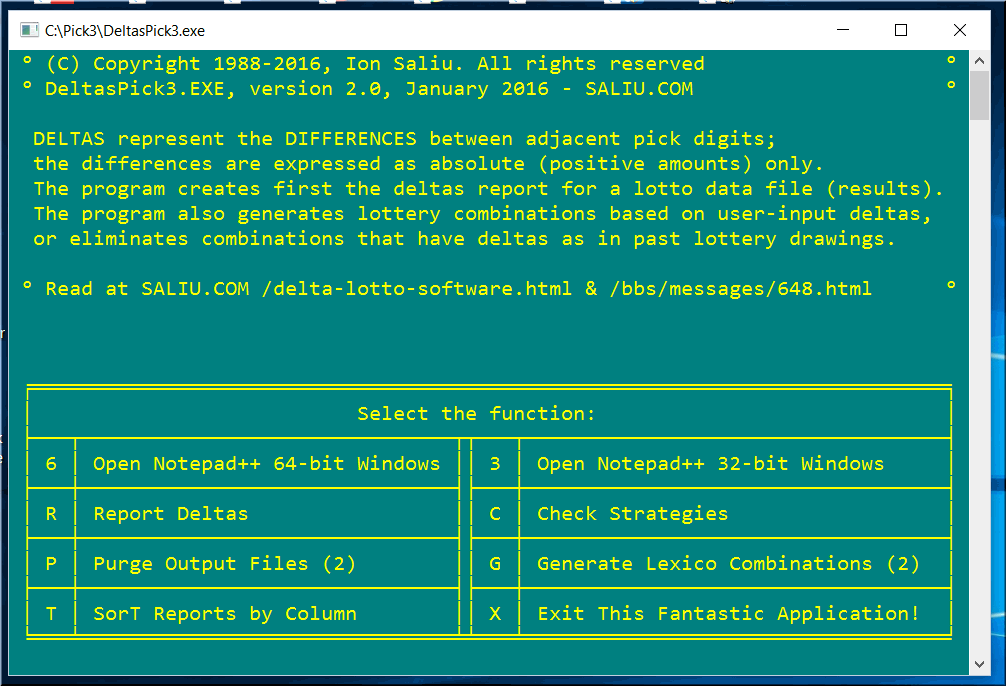
Delta might sound like a curious word in lottery science. It is the name of the letter D in Classical Greek. It has nothing to do with philosophy or "It sounds Greek to me". D or delta stands for difference in mathematics, statistics especially. If 7 and 13 are adjacent (neighboring) numbers in a lotto drawing, the delta is 13 7 = 6. The deltas are positive numbers only; e.g. even if we deduct 7 13 is not 6, but always 6. The pick (or daily or digit) lottery games can have deltas equal to 0, as the pick games can have repeat elements (e.g. 599).
This 6-number lotto drawing in Pennsylvania Lottery 11 19 33 44 46 47 has the following 5 deltas: 8 14 11 2 1. Shouldn't be 6 deltas for 6 lotto numbers for example deducting the first number from the sixth number? Why, no. It is superfluous. That virtual 6th delta simply represents the sum of the 5 real deltas. If generating combinations from 6 deltas, the result is exactly the same as generating lotto combinations from the 5 real deltas!
The same is true about the digit lottery games. This pick-4 drawing in Pennsylvania Lottery 4 3 3 8 has the following 3 deltas: 1 0 5. In this case, we could calculate a 4th delta, a meaningful one (8 4 = 4). My lottery software, however, does not apply such a rule in order to keep similarity across lottery games.
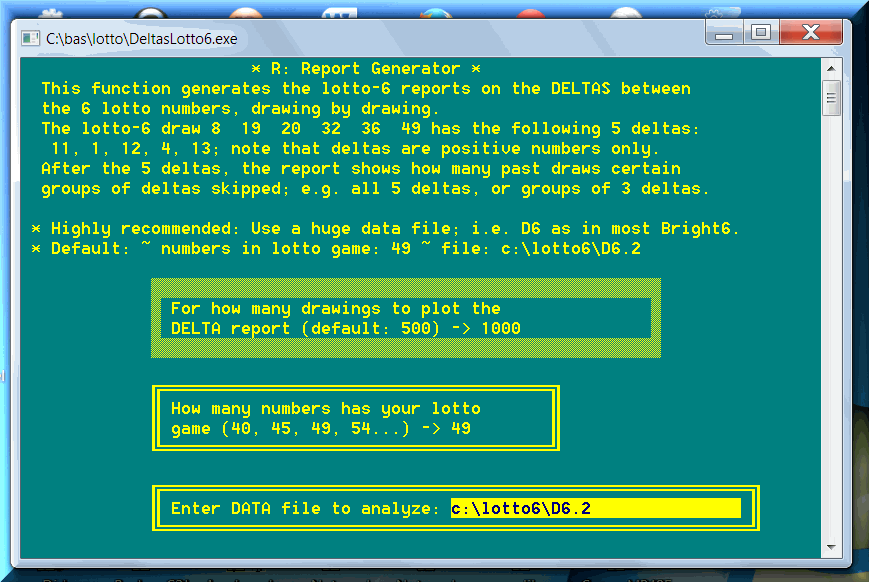
The delta lottery software is fast, including the 6-number lotto games as far as the reporting is concerned. A 5-year old desktop app analyzes 1000 real lottery drawings against 5 million lines in a D6 file in around 5 minutes. A D6 data file consists of at least 12 million lines (real and simulated drawings) as required by the Bright / Ultimate integrated lottoery software. For DeltasLotto6, however, just 4 5 million draws to analyze is a sufficient range. Read the following screen in the reporting function:
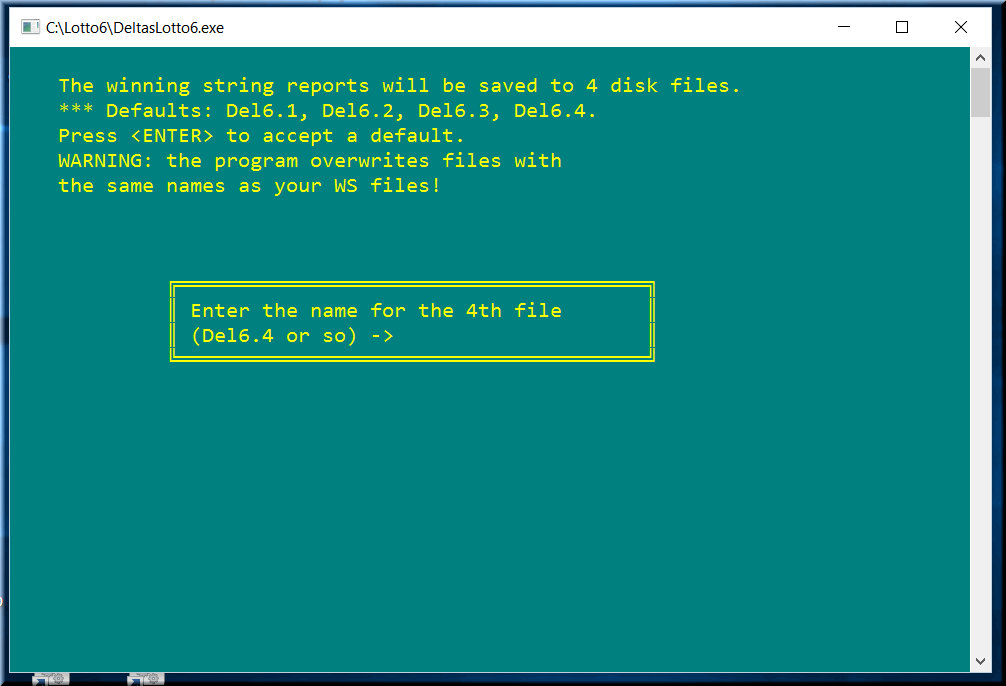
Here is a fragment of the report for a 6/49 lotto game
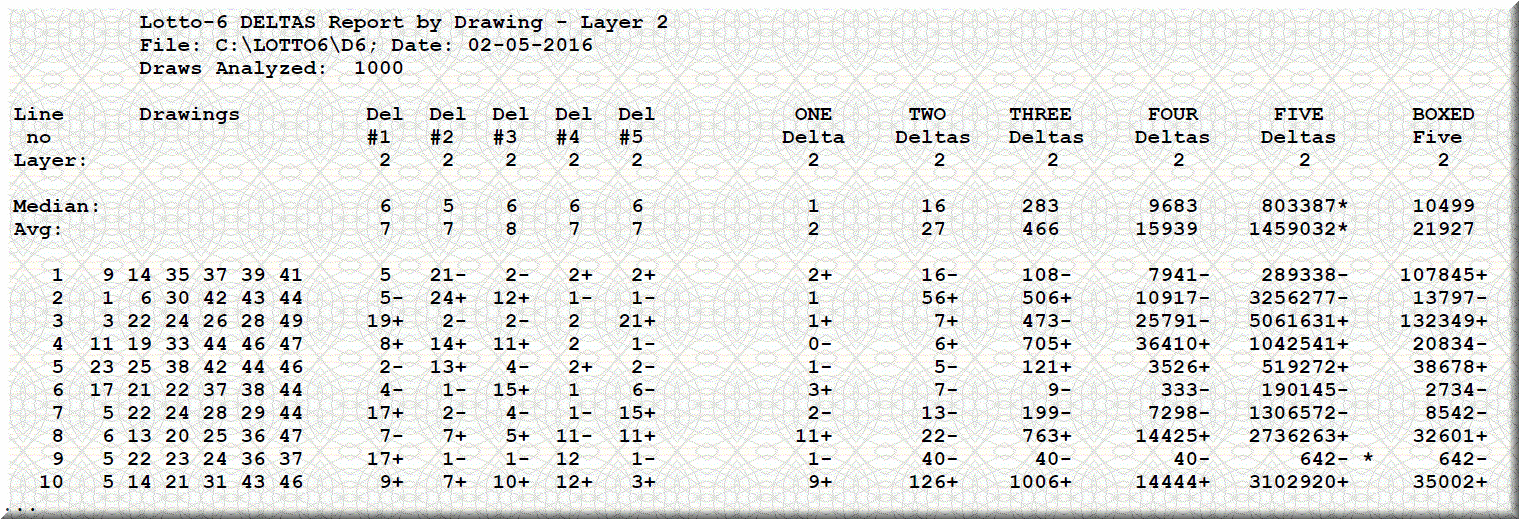
Del#1 represents the difference between the first lotto number in the drawing (e.g. 9) and the second number (e.g. 14). Del#5 represents the difference between the 5th number in the lotto drawing (e.g. 39) and the 6th number (e.g. 41). Most deltas are low: between 1 and the median 6. The fewest deltas are in the 20s; it is extremely rare to see deltas in the 30s. I am referring here to the 6 of 49 lotto.
The last area of the report shows the skips of all groups of deltas; i.e. how many drawings elapsed between two hits of a particular group. We see in line 1 that ONE Delta is 0. That means, the group hit in two consecutive draws: Del#1 was 5 in lines (drawings) #1 and #2. In line 2, ONE Delta is 1. That means, the group skipped one draw: Del#1 was 1 in lines (drawings) #2 and #4; the group didn't hit in line 3.
TWO Deltas group in line #3 shows 9. We count to 9 beginning immediately after line 3 and reach line #13 (13 3 1 = 9). We can notice that Del#2 and Del#4 repeated.
The THREE, FOUR, and FIVE delta groups represent exactly their labels. BOXED Five represents the permutations of all 5 Dels in the first section of the report. There are 120 permutations of 5 elements. The report looks for all 120 possibilities and reports the first occurrence it found. FIVE Deltas filter only shows the 12345 permutation; BOXED Five looks for 12345, and 12354, and 12543 .... all the way to 54321.
The FIVE Deltas group can reach very high levels, as in the cases marked by the asterisk. Actually, those values were over 4 million, even over 5 million! The median is 797908. Translated, it means that in more than half of total drawings, the delta no-repeat is over 700,000. BOXED Five itself reaches its own huge values, as in the cases marked by the asterisks. It is not usual for all five deltas, straight or boxed, to repeat. Tell that, in your face, to them mystics who scream that a lotto 6/49 draw can repeat the very next drawing... and again... and again... It hasn't happened anywhere in the world in our lifetime! But what's the big deal IF it happens in one or two lotto games once in a lifetime or two? There are hundreds of lottery games worldwide!
I discovered also another mathematical relationship I already coined: Reversed Birthday Paradox. (Some sore losers with emotional troubles curse me for achieving discoveries AND taking full credit!) The Reversed Birthday Paradox calculates that some 4400 are necessary for a 6/49 lotto drawing to repeat not necessarily the last combination drawn. And the degree of certainty DC for a repeat to happen is only 50%... I know and I heard that there are cashbecks out there who always play the last combination drawn in their lotto game!
Line Drawings DelP DelP DelP DelP DelP DelP
no #1 #2 #3 #4 #5 #6
1 9 14 35 37 39 41 8+ 8- 5- 5- 4- 3-
2 1 6 30 42 43 44 2 16 6 16 15 5
3 3 22 24 26 28 49
As all genuine users of my lottery software know, a strategy represents a collection of filters selected from specific reports; the values selected are then fed to specific combination generators. Selecting filter values, however, requires diligence, patience and confidence. The best way to observe applicable filter values is sorting the reports by column. My lottery software provides auxiliary functions to sort files by column and by line. In the case of this type of software, the pertinent function is T = Sort Reports by Column. Here is what the report looks like after sorting by the BOXED Five column (filter)
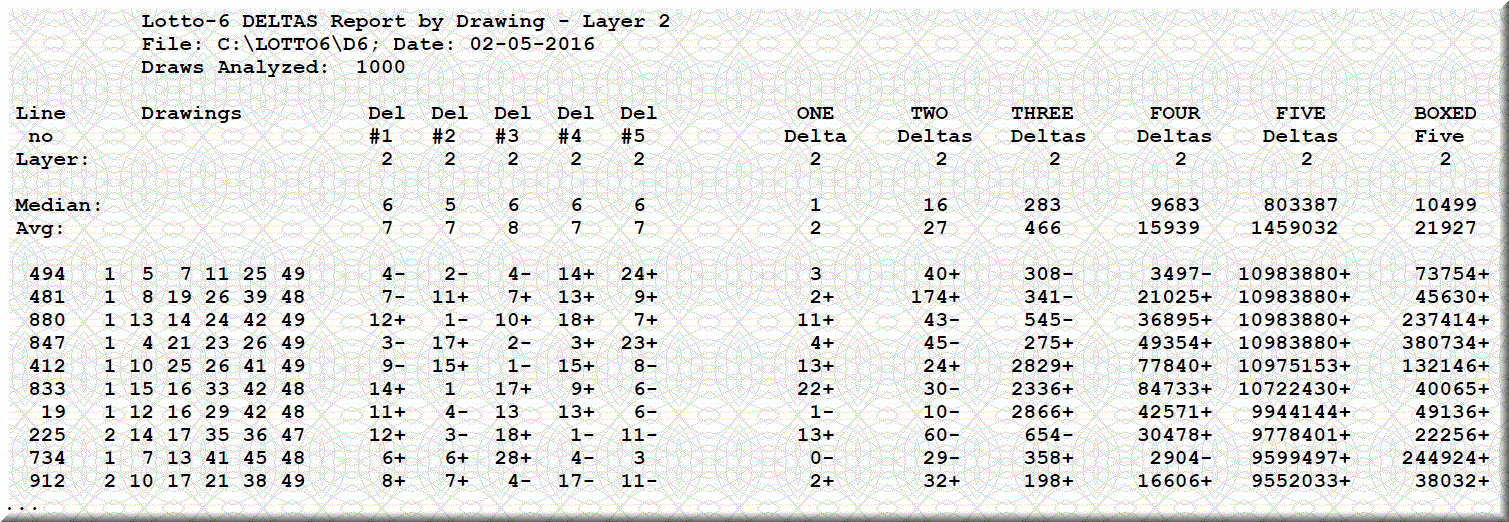
A.
The top half of the sorted report shows some huge values for BOXED Five (over 200,000) and also FIVE Deltas (over 3 million, actually over 4000000, even 5000000+)! Those values are to be used with the minimum levels of the respective filters, as you well know by now. They would certainly smash the odds! I got some bad news, however. Working with such huge filters takes considerable time to generate combinations for a 6-49 lotto game. I did my best to implement the fastest algorithms yet, there are way too many calculations for the processor! The 5/43 lotto game I tested is a lot more manageable. The pick lottery software is fantastically faster: It takes just seconds sometimes generating combinations.
I kept the FIVE Deltas and BOXED Five thinking they can be handled with patience. Not to mention that the computers are getting faster quite rapidly. You can generate combinations from huge minimum filters and save them to an output file. You can reuse that file for many drawings (of course, feeding it to the Purge functions in my lotto software).
The bottom half of the sorted report shows BOXED Five filter values to be used mainly with the maximum levels of the filter. Or, even both levels; e.g. minimum = 10 and maximum = 200. As you notice, you can add high values for FIVE Deltas minimum and also the other delta groups.
B.
Another type of lotto strategy is based on the first area of the report: From Del#1 to Del#5. One looks at the columns one by one and tries to predict the next Del value. One can see that lower Del values repeat more often. I see in column #1 that value 3 skipped too many (in my estimation) drawings, meanwhile the same value shows up more often in other Del columns. The same is true about the value 4 in column #2; value 3 in column #3; value 5 in column #4; value 7 in column #7. One can look also for 10-15 values that haven't occurred in a while. Do not choose the same value for all Dels. Do not choose Del values in lexicographic order (e.g. 1, 2, 3, 4, 5 or vice versa 5, 4, 3, 2, 1). Most likely they won't occur in a lifetime or two.
You can use all individual deltas, or only one or two of them. Thus, you can disable some filters. Disabling a filter is accomplished by leaving the field blank at the screen prompt; just press Enter.
The + or - sign can help too. The + sign indicates an increase from the previous drawing, while the sign means a decrease from the previous draw.
C.
Apply the 5 individual deltas (Del) to the LIE elimination feature of LotWon lottery software. As per the above paragraph, you can enter all 5 Dels in lexicographic order (e.g. 1, 2, 3, 4, 5 or vice versa 5, 4, 3, 2, 1). They are very good candidates for the LIE elimination functions. If you plot real lottery drawings on the grid cards, it is very rare to see more than 3 lotto numbers on the same line or in the same column.
We can notice that the majority of the drawings do not have any Del 20 or larger. In the 6-49 game, typing 20 for one Del generates 118,755 combosnations. That means a total of 593,775 for all 5 Dels. Place all those unwanted combinations in a LIE file and use it often.
I haven't seen a 6 of 49 lotto case with any Del being 30 or larger. One Del set at 30 generates 11,628 combinations for a total of 58,140 for all 5 individual deltas. One Del set at 31 generates 8,568 combinations for a total of 42,840 for all 5 Dels. Put them all combosnations in a permanent LIE file.
By the way: There is a limit to an individual delta. The maximum a Del can reach is equal to N K + 1; for 49/6 is 49 6 + 1 = 44. It always generates 1 combo: 1, 45, 46, 47, 48, 49. The limit of deltas is 9 for pick games.
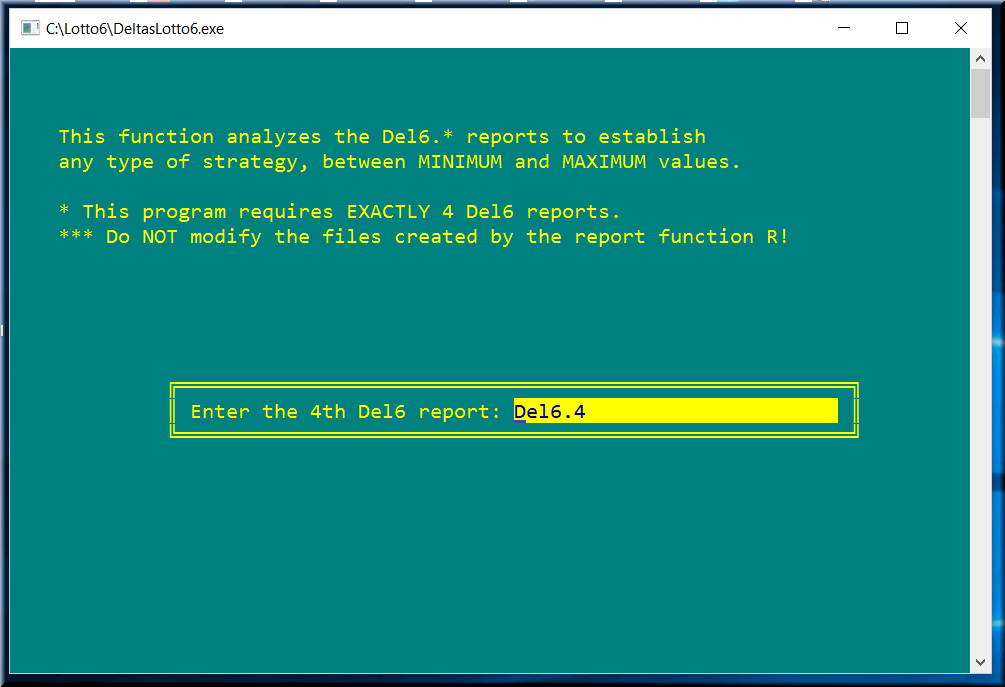
Version 2 of the software implements also strategy checking. You selected a lottery strategy; i.e. set the value of a key filter to very high or very low levels (you might have also set more moderate values to a few auxiliary filters). You want to know now if the respective strategy hit more than once before. If so, next you want to know in what lottery drawings the strategy hit. Finally, you want to see how many draws the lottery strategy skipped between hits and what the skip median was.
You might want to know that not all filters are equal. I discussed the issue several times at this very site and in public forums. I divide the filters in static and dynamic. I do take full credit for the discovery of the dynamic lotto filters in the 1980s. Most of the filters in my lottery software are dynamic.
I held the static filters in low regards until early 2000s. After I coined the term lottery filters, other software developers started to incorporate filters in their programs. But they haven't been able to figure out the dynamic filters, so they only employed static restrictions (or reduction parameters, or eliminating conditions, or... filters). And these are such static filters: odd/even, high/low. A few developers have tried also lotto decades and/or last digits.
There are serious problems related to the static filters: They are very streaky and inefficient. The static filters always eliminate the same amount of lottery combinations. For example, playing 3-odds & 3-even in a 6/49 lotto game always leaves 4,655,200 combinations always the same combinations. Besides, how efficient is to "play" 4,655,200 lotto combinations?! I found a better method to utilize static lottery filters. I coined another term: LIE elimination strategy. Instead of generating combinations "to play", I apply static filters to generate combinations "NOT to play". You might have already read here several dedicated pages dedicated to the LIE elimination strategy or REVERSED lottery strategy.
So, not all lottery filters were "born" equal. Here is a test I did while creating this strategy checking function in this lottery delta software. Del_#1 and Del_#2 are static filters. They always generate the same amount of combinations (pick-3 straight sets, in this case). I took a random case: Del_#1 = 7 and Del_#2 = 7. The strategy occurs just 4 times in 1000 lottery drawings and it always generates 6 straight sets. There is a better pick-3 strategy, while still utilizing on static filter; e.g. Del_#1 = 7 and Del_#2 not set (can take any value). This time, I also employ a couple of dynamic filters: BOXED Two = 100 and TWO Deltas = 200. This static AND dynamic strategy generates the same amount of combinations: 6. This filter setting, however, occurs around 17 times in 1000 draws! A fourfold increase in efficiency!
You already know that my lottery strategies can also enable just a few more lottery filters at run-time (very safe values). Here is a pick-3 lottery strategy purely based on just one dynamic filter: BOXED Two = 450. The strategy hit 14 times in 1000 drawings. It generates 2 straight sets (0 9 0 and 9 0 9 at this time of writing). You can still employ a few more filters, at very safe levels, at run-time. An interesting phenomenon happens now and then: NO combination will be generated. More often than not, it happens not because the few additional filters were wrongly set but because the strategy (the pivot filter) simply was not scheduled to hit. You just saved a couple of bucks that drawing!
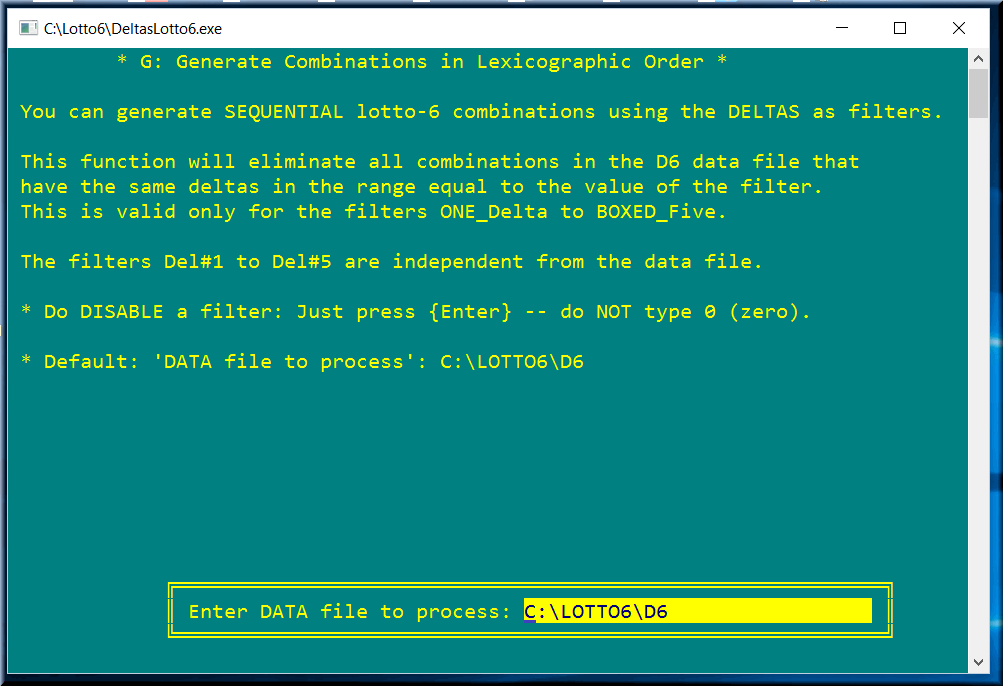
1. Generator U = Generate User-Input Deltas
You type numbers at the screen prompts; e.g. Del#1 = 5; Del#2 = 1; Del#3 = 11, etc. You don't have to set every Del filter: User can disable some filters. Disabling a filter is accomplished by leaving the field blank at the screen prompt; just press Enter. Usually in LotWon lotto software disabling a filter is equivalent to typing 0. Problem is, 0 is a valid delta in the pick lotteries. Therefore, the best practice is to press Enter for the filter you want to disable. If you want a Del equal to 0, you must type 0 instead of pressing Enter.
The parameters as set in the screen above (Del#1 = 0 and Del#2 disabled will always generate 100 pick 3 straight sets. The first 2 digits are equal and followed by one of the 10 digits; e.g. 880, 881, 882...)
2. Generator E = Eliminate Past Deltas
This is exactly how you do it in the traditional LotWon lottery software. You previously chose a strategy and you type the filter values at the corresponding screen prompts. Every filter has a minimum level and a MAXimum level. You can set all filters, or, much more often, you only select one or 2-3 filters, while disabling the rest. For example, set only BOXED Five; minimum = 10 and MAXIMUM = 200;
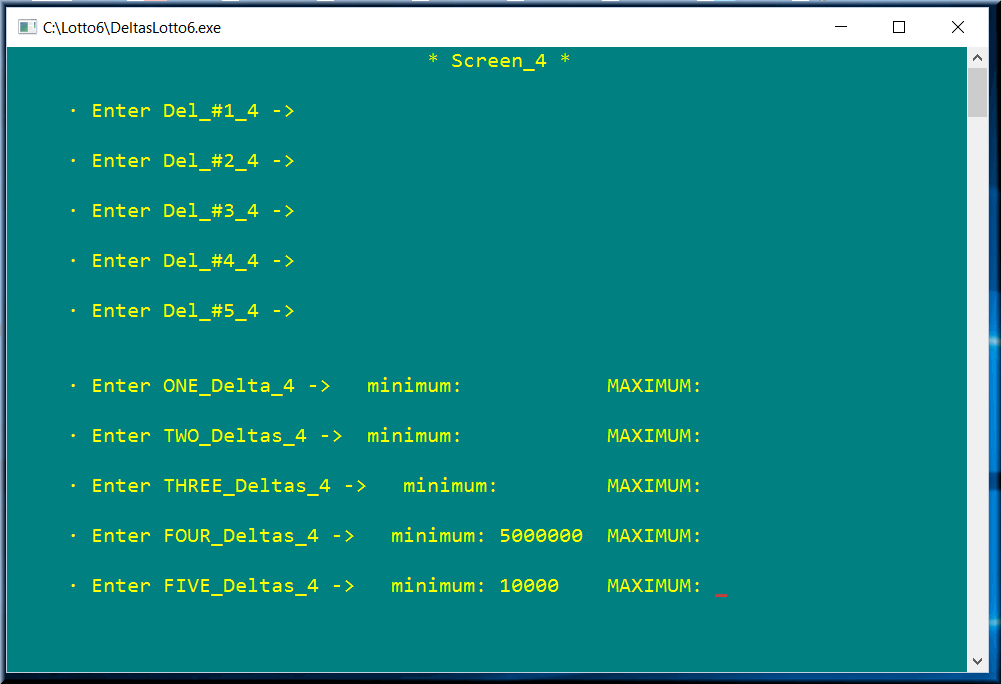
The output file can be:
The output file must be compliant with the LotWon or MDIEditor Lotto format:
The Purge program in this type of delta lotto software has the same two functions as in the Generate module (U and E).


Home | Search | New Writings | Fundamental Formula | Odds, Generator | Contents | Forums | Sitemap
